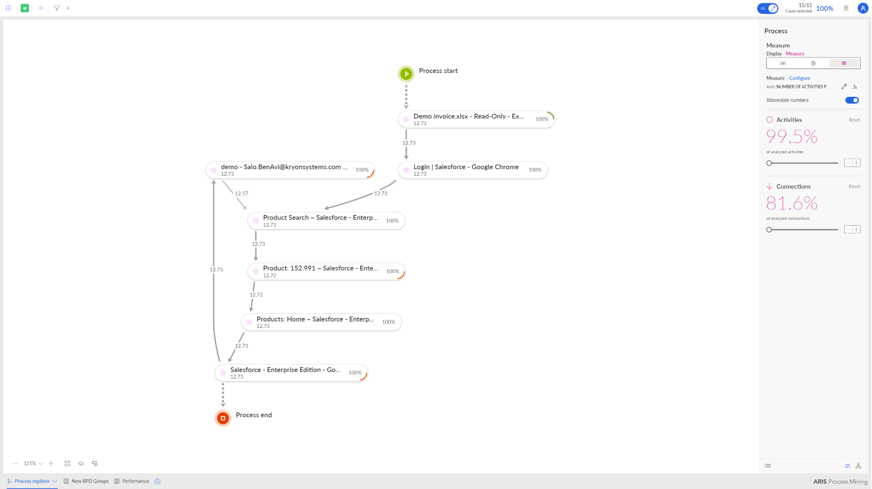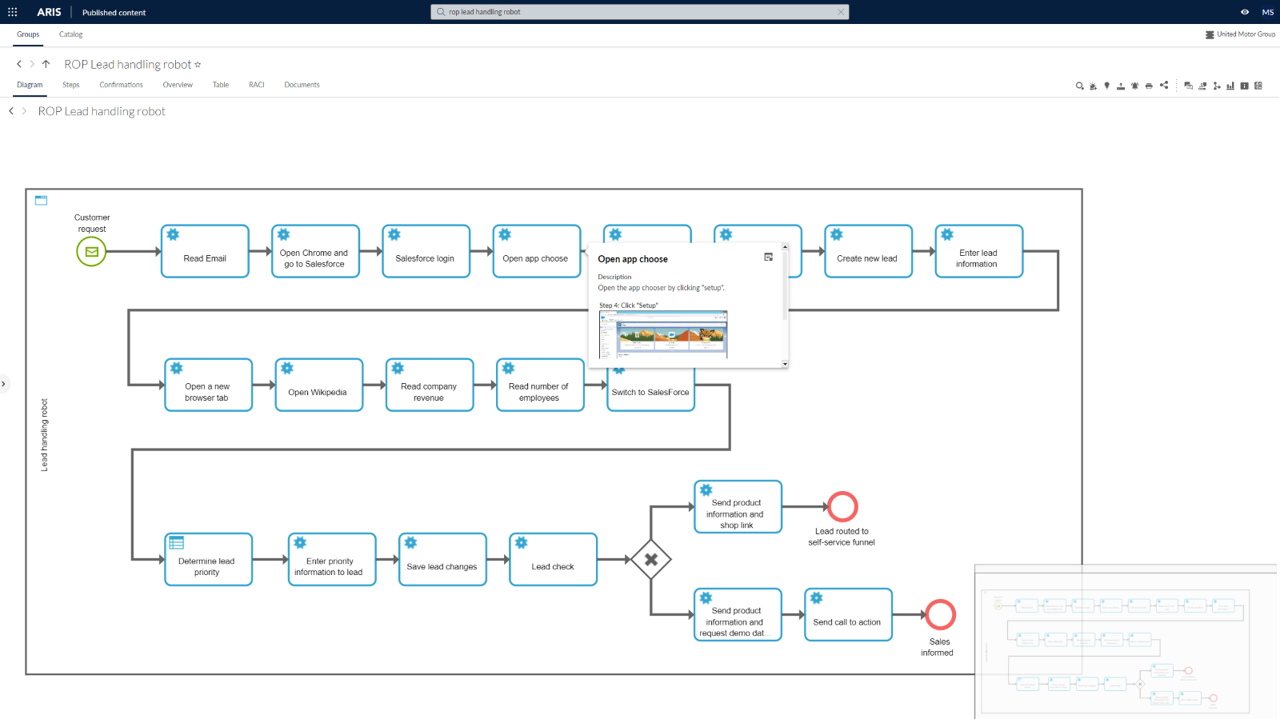Discovering the Hidden Gems of Your Business Processes with the ARIS Suite
Uncover valuable insights, streamline operations, and make data-driven decisions to optimize efficiency and unlock your business’s full potential for growth and success.

Task Mining and Process Mining are powerful techniques that allow you to gain visibility in your complete business process and uncover insights that would not have been visible without a combined approach.
By analyzing the data from your already running processes, you can identify unexpected insights, improve efficiency, and unlock new opportunities for growth. Those hidden gems allow you to unlock the potential of your business processes today with Task Mining, Process Mining, and your process repository in the ARIS suite!
1. Introduction to Task Mining and Process Mining
By looking at the problems organizations are facing today, it often turns out that visibility has been an important topic for tens of years already. But if you want to change something it is always good to know how things behave. So, if you want to change the traffic flow of a city, first you need to get a map of the available road network and understand how traffic is flowing today.
The same applies to processes that run into your business. You need to know how they act before you can make essential decisions to redesign them. Process Mining and Task Mining are two technologies that allow you to gain insights into the existing behavior of your business processes by extracting data from different data sources.
To have an end-to-end overview of the full process and what the data sources you need to look at are, first, you need to know that not all processes are fully automated or fully supported by an application software like ERP or CSM systems. In addition to that, there are also manual tasks in those processes that are performed by human workers. But how can we now get full visibility of those processes when it is not possible to track all parts of it in application systems?
To facilitate this, you need to compile the system log’s findings and enrich the results of the manual steps. This can be done using the ARIS Task Mining solution. Task mining involves analyzing how employees interact with different software applications to identify inefficiencies and areas for improvement. Task Mining facilitates screen recorders that run on the computer of an employee. Without any connection to a system other than the user interface that has been captured, these recorders capture activities and analyze the resulting data to spot patterns and trends.
Process mining, on the other hand, analyzes the actual processes that are running inside an IT system and produces data that is stored in event logs or tables in the database of the system itself. Those analyses are used within a business to identify bottlenecks and other inefficiencies.
By using these two techniques in tandem, businesses can gain a much deeper understanding of their operations and identify areas where they can make improvements. Whether you are looking to improve customer service, streamline your production processes, or optimize your supply chain, task mining and process mining can help you achieve your goals.
2. Identifying Hidden Gems in Your Business Processes
Identifying hidden gems in your business processes is crucial for improving overall efficiency and productivity. With the help of task mining and process mining, you can uncover valuable insights and opportunities for optimization that may have gone unnoticed. These hidden gems could be anything from a small, time-saving improvement to a major process overhaul that could save your company significant resources.
By analyzing data from various sources, such as employee activity logs and customer feedback, you can identify areas of improvement and implement changes that will have a positive impact on your bottom line. Do not underestimate the power of these hidden gems – they could be the key to unlocking your business’s full potential!
With the right tools, you can uncover these areas of improvement and pave the way for a more efficient and successful future for your company. The successful combination of process mining with task mining technologies gives you a full picture, incorporating multiple granularities of your business processes. But that is not all, you can also save your findings as processes in the ARIS process repository where all findings can be reused for specific projects, your business transformation, documentation, or any ongoing continuous improvement process. But how can this work together in ARIS?

Figure 1: Task Mining Analysis in ARIS Process Mining
Task mining can automatically generate process models that depict the actual sequence of steps taken by users to complete tasks. These process models are often more detailed and up to date than the existing documentation or assumptions about how work is done. It also helps identify variations and deviations from the standard process models. By analyzing the data, you can discover instances where users follow different paths, use workarounds, or encounter bottlenecks. This information allows you to understand the actual behavior of users and refine their process models accordingly.
In the given example, the flow derived from a task mining recording is visualized in ARIS Process Mining. It becomes visible that customer information is transferred into a CRM system using manual steps that include the receiving of e-mail and then copying of the information into the system. However, it also becomes clear that more information is needed; in that case, an estimated company revenue and the number of employees. This information is searched on the web and then transferred into the created lead by a worker. In addition to identifying variations, task mining provides insights into user behavior, including repetitive tasks, time-consuming activities, and areas where productivity can be improved. By analyzing this data, organizations can identify opportunities for automation, simplification, or optimization of processes to enhance efficiency and reduce operational costs.
Task mining also helps uncover user frustrations, pain points, and inefficiencies in software applications or user interfaces. By identifying areas where users struggle or encounter usability issues, organizations can redesign interfaces or workflows to improve the overall user experience.
Moreover, task mining supports compliance and risk management efforts. It allows to gain data for an analysis in Process Mining to identify potential compliance risks or violations by comparing actual user behavior with established policies or regulations. This capability allows organizations to pinpoint areas where non-compliance occurs and take corrective actions to ensure adherence to regulatory requirements.
Task mining is an on-going process that enables organizations to continuously monitor and refine process models over time. By regularly capturing and analyzing user interactions, organizations can track changes in behavior, identify emerging patterns, and adapt their process models to reflect the evolving work environment.

Figure 1: Detailed Task Mining based BPMN model including meta data
In summary, task mining empowers organizations to gain a deep understanding of how work is performed, identify process inefficiencies, and drive continuous improvement efforts to optimize processes and enhance user experiences.
3. Crafting a Strategy to Leverage Task Mining and Process Mining for Maximum Benefit in your Use Cases
Crafting a strategy to leverage task mining and process mining for maximum benefit is a crucial step towards discovering the hidden gems of your business processes. Task mining can help you identify the most common tasks performed by your employees, while process mining can help you visualize the entire process and pinpoint bottlenecks and inefficiencies. By combining these two technologies, you can gain a deeper understanding of your business processes, identify areas for improvement, and implement changes that will lead to increased efficiency and profitability. To get the most out of task mining and process mining, it’s important to have a clear plan in place. This plan should include specific goals, a timeline for implementation, and a team of experts who can help you analyze the data and make informed decisions. With the right strategy in place, task mining and process mining can be powerful tools for unlocking the full potential of several use cases:
Unleashing granularity: Task mining’s capacity to capture minute details about individual tasks dovetails with process mining, enabling our customers to comprehend user interactions within specific applications and their broader impact on end-to-end processes. This fusion of data empowers businesses with a deeper, more detailed understanding of the tasks performed within their operations.
Validating process discovery: Process mining’s ability to automatically discover and visualize process models relies on event logs. Integrating task mining data in this process allows for the validation and fine-tuning of these process models, incorporating the actual sequence of tasks and dynamic user interactions. This integration ensures the accuracy and completeness of process models, empowering businesses with reliable blueprints for process optimization.
Driving performance optimization: Process mining provides vital performance metrics, flagging bottlenecks and inefficiencies. By integrating task mining data, organizations can pinpoint specific tasks or user interactions that hinder performance. Armed with this granular insight, businesses can orchestrate targeted improvements and optimizations that drive process efficiency and overall performance.
Fostering user-centric enhancements: Task mining’s focus on user interactions equips organizations with a deep understanding of user behavior, pain points, and user experience. The integration of task mining and process mining enables businesses to align process optimization efforts with user needs and behaviors, fostering user-centric improvements that enhance satisfaction and productivity.
4. Conclusion: Unlocking the Hidden Value with Task Mining and Process Mining
In conclusion, task mining and process mining are powerful tools that can help businesses unlock hidden value within their processes. By analyzing every step of a process and identifying areas for improvement, companies can streamline their operations, reduce costs, and increase efficiency. Task mining provides a granular view of how employees interact with software applications, enabling organizations to identify bottlenecks and inefficiencies in their workflows. Process mining, on the other hand, provides a high-level view of entire business processes, allowing companies to identify areas for optimization and automation.
By combining these two approaches, businesses can gain a comprehensive understanding of their processes and make data-driven decisions to improve their operations. Ultimately, task mining and process mining can help companies achieve their goals, whether that’s reducing costs, improving customer satisfaction, or increasing revenue. With these tools, businesses can discover the hidden gems of their processes and unlock their full potential.